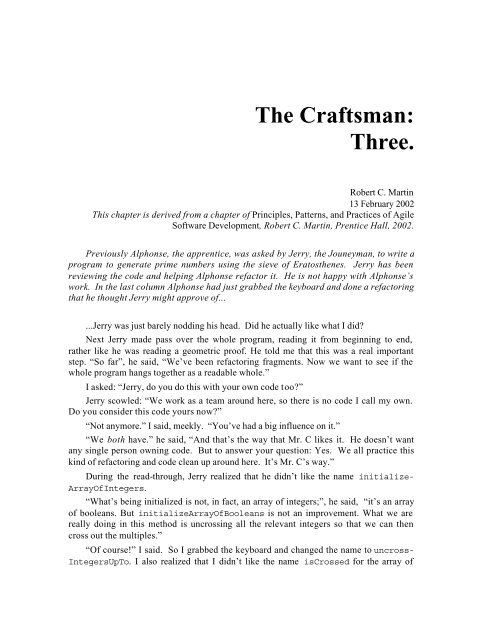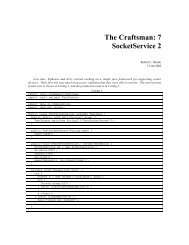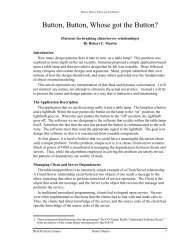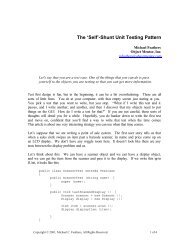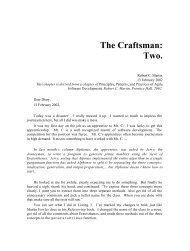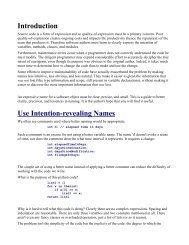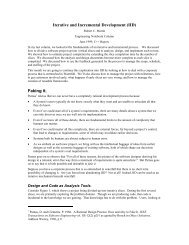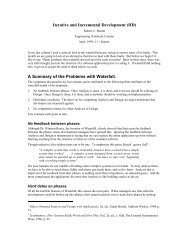The Craftsman: Three. - Object Mentor
The Craftsman: Three. - Object Mentor
The Craftsman: Three. - Object Mentor
You also want an ePaper? Increase the reach of your titles
YUMPU automatically turns print PDFs into web optimized ePapers that Google loves.
<strong>The</strong> <strong>Craftsman</strong>:<br />
<strong>Three</strong>.<br />
Robert C. Martin<br />
13 February 2002<br />
This chapter is derived from a chapter of Principles, Patterns, and Practices of Agile<br />
Software Development, Robert C. Martin, Prentice Hall, 2002.<br />
Previously Alphonse, the apprentice, was asked by Jerry, the Jouneyman, to write a<br />
program to generate prime numbers using the sieve of Eratosthenes. Jerry has been<br />
reviewing the code and helping Alphonse refactor it. He is not happy with Alphonse’s<br />
work. In the last column Alphonse had just grabbed the keyboard and done a refactoring<br />
that he thought Jerry might approve of...<br />
...Jerry was just barely nodding his head. Did he actually like what I did<br />
Next Jerry made pass over the whole program, reading it from beginning to end,<br />
rather like he was reading a geometric proof. He told me that this was a real important<br />
step. “So far”, he said, “We’ve been refactoring fragments. Now we want to see if the<br />
whole program hangs together as a readable whole.”<br />
I asked: “Jerry, do you do this with your own code too”<br />
Jerry scowled: “We work as a team around here, so there is no code I call my own.<br />
Do you consider this code yours now”<br />
“Not anymore.” I said, meekly. “You’ve had a big influence on it.”<br />
“We both have.” he said, “And that’s the way that Mr. C likes it. He doesn’t want<br />
any single person owning code. But to answer your question: Yes. We all practice this<br />
kind of refactoring and code clean up around here. It’s Mr. C’s way.”<br />
During the read-through, Jerry realized that he didn’t like the name initialize-<br />
ArrayOfIntegers.<br />
“What’s being initialized is not, in fact, an array of integers;”, he said, “it’s an array<br />
of booleans. But initializeArrayOfBooleans is not an improvement. What we are<br />
really doing in this method is uncrossing all the relevant integers so that we can then<br />
cross out the multiples.”<br />
“Of course!” I said. So I grabbed the keyboard and changed the name to uncross-<br />
IntegersUpTo. I also realized that I didn’t like the name isCrossed for the array of
ooleans. So I changed it to crossedOut. <strong>The</strong> tests all still run. I was starting to enjoy<br />
this; but Jerry showed no sign of approval.<br />
<strong>The</strong>n Jerry turned to me and asked me what I was smoking when I wrote all that<br />
maxPrimeFactor stuff. (See Listing 6.) At first I was taken aback. But as I looked the<br />
code and comments over I realized he had a point. Yikes, I felt stupid! <strong>The</strong> square root<br />
of the size of the array is not necessarily prime. That method did not calculate the<br />
maximum prime factor. <strong>The</strong> explanatory comment was just wrong. So I sheepishly<br />
rewrote the comment to better explain the rationale behind the square root, and renamed<br />
all the variables appropriately. <strong>The</strong> tests all still ran.<br />
Listing 6<br />
TestGeneratePrimes.java (Partial)<br />
private static int calcMaxPrimeFactor()<br />
{<br />
// We cross out all multiples of p, where p is prime.<br />
// Thus, all crossed out multiples have p and q for<br />
// factors. If p > sqrt of the size of the array, then<br />
// q will never be greater than 1. Thus p is the<br />
// largest prime factor in the array, and is also<br />
// the iteration limit.<br />
double maxPrimeFactor = Math.sqrt(isCrossed.length) + 1;<br />
return (int) maxPrimeFactor;<br />
}<br />
“What the devil is that +1 doing in there” Jerry barked at me.<br />
I gulped, looked at the code, and finally said: “I was afraid that a fractional square<br />
root would convert to an integer that was one too small to serve as the iteration limit.”<br />
“So you’re going to litter the code with extra increments just because you are<br />
paranoid” he asked. “That’s silly, get rid of the increment and run the tests.”<br />
I did, and the tests all ran. I thought about this for a minute, because it made me<br />
nervous. But I decided that maybe the true iteration limit was the largest prime less than<br />
or equal to the square root of the size of the array.<br />
“That last change makes me pretty nervous.” I said to Jerry. “I understand the rationale<br />
behind the square root, but I’ve got a nagging feeling that there may be some corner<br />
cases that aren’t being covered.”<br />
“OK,” he grumbled. “So write another test that checks that.”<br />
“I suppose I could check that there are no multiples in any of the prime lists between<br />
2 and 500.”<br />
“OK, if it’ll make you feel better, try that.” he said. He was clearly becomming<br />
impatient.<br />
So I wrote the testExhaustive function shown in Listing 8. <strong>The</strong> new test passed,<br />
and my fears were allayed.
<strong>The</strong>n Jerry relented a bit. “It’s always good do know why something works;” said<br />
Jerry. “and it’s even better when you show you are right with a test.”<br />
<strong>The</strong>n Jerry scrolled one more time through all the code and tests (shown in listings 7<br />
and 8). He sat back, thinking for a minute, and said: “OK, I think we’re done. <strong>The</strong> code<br />
looks reasonably clean. I’ll show it to Mr. C.”<br />
<strong>The</strong>n he looked me dead in the eye and said: “Remember this. From now on when<br />
you write a module, get help with it and keep it clean. If you hand in anything below<br />
those standards you won’t last long here.”<br />
And with that, he strode off.<br />
Listing 7<br />
PrimeGenerator.java (final)<br />
/**<br />
* This class Generates prime numbers up to a user specified<br />
* maximum. <strong>The</strong> algorithm used is the Sieve of Eratosthenes.<br />
* Given an array of integers starting at 2:<br />
* Find the first uncrossed integer, and cross out all its<br />
* multiples. Repeat until there are no more multiples<br />
* in the array.<br />
*/<br />
public class PrimeGenerator<br />
{<br />
private static boolean[] crossedOut;<br />
private static int[] result;<br />
public static int[] generatePrimes(int maxValue)<br />
{<br />
if (maxValue < 2)<br />
return new int[0];<br />
else<br />
{<br />
uncrossIntegersUpTo(maxValue);<br />
crossOutMultiples();<br />
putUncrossedIntegersIntoResult();<br />
return result;<br />
}<br />
}<br />
private static void uncrossIntegersUpTo(int maxValue)<br />
{<br />
crossedOut = new boolean[maxValue + 1];<br />
for (int i = 2; i < crossedOut.length; i++)<br />
crossedOut[i] = false;<br />
}<br />
private static void crossOutMultiples()<br />
{
}<br />
int limit = determineIterationLimit();<br />
for (int i = 2; i
import junit.framework.*;<br />
public class TestGeneratePrimes extends TestCase<br />
{<br />
public static void main(String args[])<br />
{<br />
junit.swingui.TestRunner.main(<br />
new String[] {"TestGeneratePrimes"});<br />
}<br />
public TestGeneratePrimes(String name)<br />
{<br />
super(name);<br />
}<br />
}<br />
public void testPrimes()<br />
{<br />
int[] nullArray = PrimeGenerator.generatePrimes(0);<br />
assertEquals(nullArray.length, 0);<br />
}<br />
int[] minArray = PrimeGenerator.generatePrimes(2);<br />
assertEquals(minArray.length, 1);<br />
assertEquals(minArray[0], 2);<br />
int[] threeArray = PrimeGenerator.generatePrimes(3);<br />
assertEquals(threeArray.length, 2);<br />
assertEquals(threeArray[0], 2);<br />
assertEquals(threeArray[1], 3);<br />
int[] centArray = PrimeGenerator.generatePrimes(100);<br />
assertEquals(centArray.length, 25);<br />
assertEquals(centArray[24], 97);<br />
public void testExhaustive()<br />
{<br />
for (int i = 2; i
What a disasater! I thought sure that my original solution had been top-notch. In<br />
some ways I still feel that way. I had tried to show off my brilliance, but I guess Mr. C<br />
values collaboration and clarity more than individual brilliance.<br />
I had to admit that the program reads much better than it did at the start. It also works<br />
a bit better. I was pretty pleased with the outcome. Also, in spite of Jerry’s gruff attitude,<br />
it had been fun working with him. I had learned a lot.<br />
Still, I was pretty discouraged with my performance. I don’t think the folks here are<br />
going to like me very much. I’m not sure they’ll ever think I’m good enough for them.<br />
This is going to be a lot harder than I thought.<br />
To Be Continued Next Month


